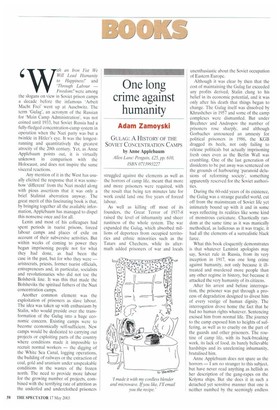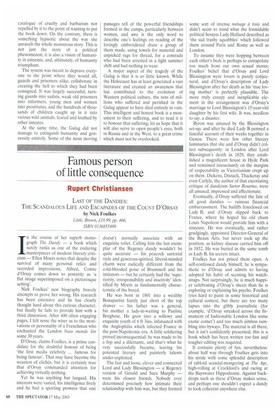One long crime against humanity
Adam Zamoyski
GULAG: A HISTORY OF THE SOVIET CONCENTRATION CAMPS by Anne Applebaum Allen Lane! Penguin, £25, pp. 610, ISBN 0713993227 C withan Iron Fist We
Will Lead Humanity to Happiness!' and 'Through Labour — Freedom!' we re among
the slogans on view in Soviet prison camps a decade before the infamous -Arbeit Macht Frei' went up at Auschwitz. The term 'Gulag', an acronym of the Russian for 'Main Camp Administration', was not coined until 1933, but Soviet Russia had a fully-fledged concentration-camp system in operation when the Nazi party was but a twinkle in Hitler's eye. It was the longestrunning and quantitatively the greatest atrocity of the 20th century. Yet, as Anne Applebaum points out, it is virtually unknown in comparison with the Holocaust, and does not inspire the same visceral reactions.
Any mention of it in the West has usually elicited the response that it was somehow 'different' from the Nazi model along with pious assertions that it was only a brief Stalinist aberration anyway. The great merit of this fascinating book is that, by bringing together all the available information. Applebaum has managed to dispel this nonsense once and for all.
Lenin and most of his colleagues had spent periods in tsarist prisons, forced labour camps and places of exile on account of their subversive activities. But within weeks of coming to power they began imprisoning people not for what they had done, as had been the case in the past, but for who they were — aristocrats, priests, former tsarist officials, entrepreneurs and, in particular, socialists and revolutionaries who did not toe the Bolshevik line. It was this that made the Bolsheviks the spiritual fathers of the Nazi concentration camps. Another common element was the exploitation of prisoners as slave labour. The idea was taken up with enthusiasm by Stalin, who would preside over the transformation of the Gulag into a huge economic concern. Existing camps were to become economically self-sufficient. New camps would be dedicated to carrying out projects or exploiting parts of the country where conditions made it impossible to recruit normal workers — the digging of the White Sea Canal, logging operations, the building of railways or the extraction of coal, gold and uranium under unspeakable conditions in the wastes of the frozen north. The need to provide more labour for the growing number of projects, combined with the terrifying rate of attrition as the underfed and underclothed prisoners struggled against the elements as well as the horrors of camp life, meant that more and more prisoners were required, with the result that being ten minutes late for work could land one five years of forced labour.
As well as killing off most of its founders, the Great Terror of 1937-8 raised the level of inhumanity and sheer nastiness of the whole system. The war expanded the Gulag, which absorbed millions of deportees from occupied territories and ethnic minorities such as the Tatars and Chechens, while its aftermath added prisoners of war and locals unenthusiastic about the Soviet occupation of Eastern Europe. Although it was clear by then that the cost of maintaining the Gulag far exceeded any profits derived, Stalin clung to his belief in its economic potential, and it was only after his death that things began to change. The Gulag itself was dissolved by Khrushchev in 1957 and some of the camp complexes were dismantled. But under Brezhnev and Andropov the number of prisoners rose sharply, and although Gorbachev announced an amnesty for political prisoners in 1986, the KGB dragged its heels, not only failing to release politicals but actually imprisoning fresh ones even as the Berlin Wall was crumbling. One of the last generation of dissidents to be put away was sentenced on the grounds of harbouring 'paranoid delusions of reforming society', something apparently reserved for the Soviet authorities.
During the 60-odd years of its existence, the Gulag was a strange parallel world, cut off from the mainstream of Soviet life yet intimately bound up with it and in some ways reflecting its realities like some kind of monstrous caricature. Chaotically random at the same time as it was manically methodical, as ludicrous as it was tragic, it had all the elements of a surrealistic black farce.
What this book eloquently demonstrates is that whatever Leninist apologists may say, Soviet rule in Russia, from its very inception in 1917, was one long crime against humanity, not only because it illtreated and murdered more people than any other regime in history, but because it attacked the very humanity of its citizens. After his arrest and before interrogation, the prisoner was put through a process of degradation designed to divest him of every vestige of human dignity. The interrogation drove home the fact that he had no human rights whatever. Sentencing excised him from normal life. The journey to the camp exposed him to heights of suffering, as well as to cruelty on the part of the guards and other prisoners. The routine of camp life, with its back-breaking work, its lack of food, its barely believable hardships and its unrelenting inhumanity, brutalised him.
Anne Applebaum does not spare us the horrors — I am no stranger to this subject, but have never read anything as hellish as her description of the gang-rapes on the Kolyma ships. But she does it in such a detached yet sensitive manner that one is neither numbed by the seemingly endless catalogue of cruelty and barbarism nor repelled by it to the point of wanting to put the book down. On the contrary, there is something hypnotic about the way she unravels the whole monstrous story. This is not just the story of a political phenomenon; it is also a vision of humanity in extremis, and, ultimately, of humanity triumphant.
The system was meant to deprave everyone to the point where they would all, guards and prisoners alike, collaborate in creating the hell to which they had been consigned. It was largely successful, turning guards into sadists, weak old prisoners into informers, young men and women into prostitutes, and the hundreds of thousands of children caught up in it into vicious wild animals, feared and loathed by other inmates.
At the same time, the Gulag did not manage to extinguish humanity and generosity entirely. Some of the most moving passages tell of the powerful friendships formed in the camps, particularly between women, and awe is the only word to describe one's feelings on reading of the lovingly embroidered dress a group of them made, using towels for material and unpicked rags for thread, for a comrade who had been arrested in a light summer shift and had nothing to wear.
A major aspect of the tragedy of the Gulag is that it is so little known. While the Holocaust has at least generated a vast literature and created an awareness that has contributed to the evolution of Western political culture, the tens of millions who suffered and perished in the Gulag appear to have died entirely in vain. This intelligent and honest book is a monument to their suffering, and to read it is to honour that suffering; let us hope that it will also serve to open people's eyes, both in Russia and in the West, to a great crime which must not be overlooked.



































































































 Previous page
Previous page